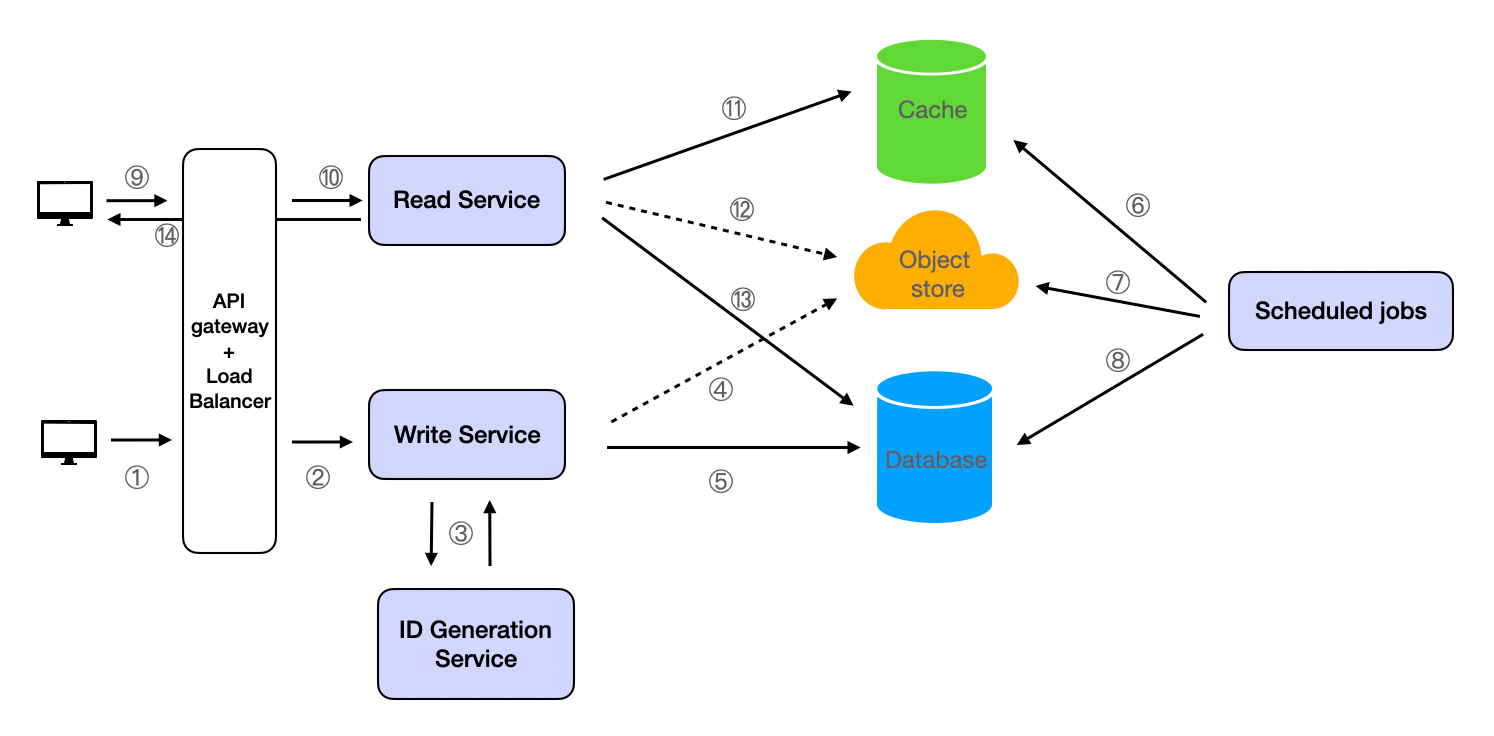Functional Requirements
- Store text: Allows users to input and save text.
- Share text: Enables users to share the stored text with others. The system should generate a unique URL for each piece of stored text, which can be shared with others for viewing.
Non-Functional Requirements
Scale requirements:
- 1M Daily Active Users
- Read:write ratio = 10:1
- Data retention for 3 months
Other requirements:
- Low latency
- High durability
- Security
Resource Estimation
Estimating the QPS (Queries per second), we can assume that each user performs 10 read operations and 1 write operation per day. So, there are 10M (1M * 10) read operations and 1M write operations per day. A day has 86400 seconds (24 * 60 * 60). This gives us a read QPS of approximately 116 (10M / 86400) and a write QPS of approximately 12 (1M / 86400).
The storage requirements can be estimated based on the average size of the text data. Assuming an average text size of 10KB, the system would need to store approximately 10GB (1M * 10KB) of data per day. Given the data retention requirement of 3 months, the total storage requirement would be approximately 900GB (90 * 10GB).
Use the resource estimator.
API Endpoint Design
The system would have two main API endpoints:
-
POST /paste: This endpoint would accept a text data and return a unique URL for the stored text.Considering the processing capacity of the system and to avoid malicious uploads, it is necessary to impose restrictions, such as limiting the data volume of a single upload to no more than 1MB. Request Body:{ "text": "The text to be stored." }Response:
{ "status": "success", "url": "https://pastebin.example/paste/{id} (The url for the stored text.)" }or when failing,
{ "status": "error", "message": "Upload failed. The data volume of a single upload should not exceed 1MB." } -
GET /{id}: This endpoint would accept a unique ID and return the corresponding text data.{ "status": "success", "text": "The stored text." }
High-Level Design
The system would consist of several components including a load balancer, application servers, a database cluster, a cache layer, and an object store service.

Grasping the building blocks ("the lego pieces")
This part of the guide will focus on the various components that are often used to construct a system (the building blocks), and the design templates that provide a framework for structuring these blocks.
Core Building blocks
At the bare minimum you should know the core building blocks of system design
- Scaling stateless services with load balancing
- Scaling database reads with replication and caching
- Scaling database writes with partition (aka sharding)
- Scaling data flow with message queues
System Design Template
With these building blocks, you will be able to apply our template to solve many system design problems. We will dive into the details in the Design Template section. Here’s a sneak peak:

Additional Building Blocks
Additionally, you will want to understand these concepts
- Processing large amount of data (aka “big data”) with batch and stream processing
- Particularly useful for solving data-intensive problems such as designing an analytics app
- Achieving consistency across services using distribution transaction or event sourcing
- Particularly useful for solving problems that require strict transactions such as designing financial apps
- Full text search: full-text index
- Storing data for the long term: data warehousing
On top of these, there are ad hoc knowledge you would want to know tailored to certain problems. For example, geohashing for designing location-based services like Yelp or Uber, operational transform to solve problems like designing Google Doc. You can learn these these on a case-by-case basis. System design interviews are supposed to test your general design skills and not specific knowledge.
Working through problems and building solutions using the building blocks
Finally, we have a series of practical problems for you to work through. You can find the problem in /problems. This hands-on practice will not only help you apply the principles learned but will also enhance your understanding of how to use the building blocks to construct effective solutions. The list of questions grow. We are actively adding more questions to the list.